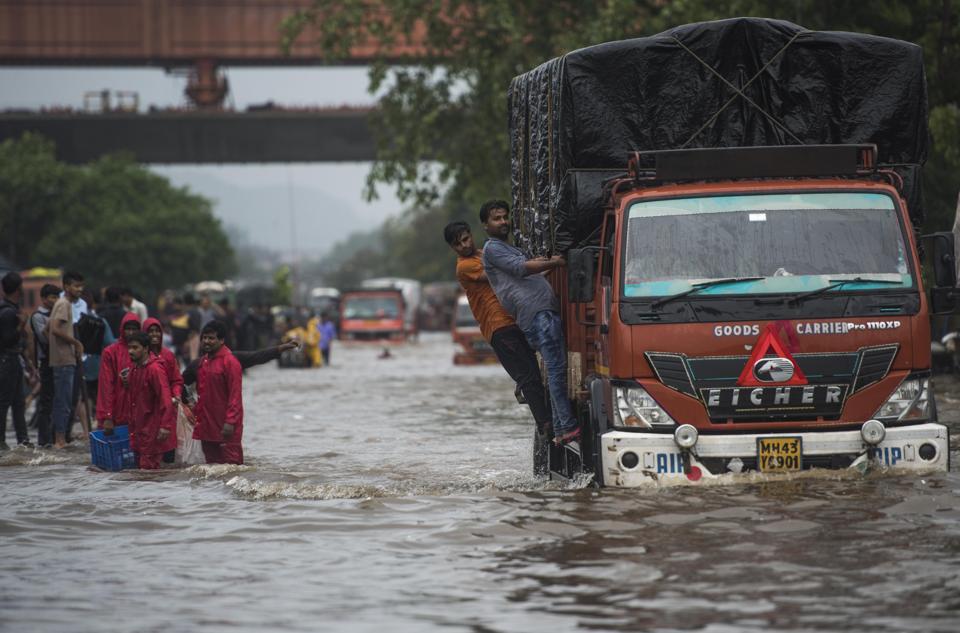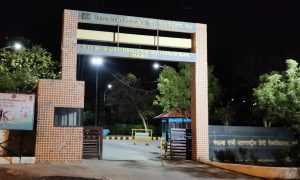Each time Mumbai is flooded after a hard rain, as it has been on three occasions this monsoon, there are two levels of responses. We citizens try to make the best of a bad situation with the resources available to us, relying partly on personal networks and partly on official information. Officials in the Brihanmumbai Municipal Corporation and the government offer the only explanation they can, which is that the unusual rain is a natural calamity.
This is correct and it isn’t. Hard and unrelenting rain during the monsoon months is a natural phenomenon; the calamity is human-made and the result of ill-preparedness and inadequate planning. With urban floods now a characteristic of the city, and climate change impact at our door, it’s time to ask if – and when – Mumbai will be flood-ready. Or better still, how it can be flood-proof.
It’s time to realise that it’s not only the unprecedented rainstorm which causes the flood but a specific model of urbanisation which places an unnatural premium on land and what urbanists call the 3Ps – pave, pipe and pump. It’s time to look beyond the capacity of the stormwater drains and water pumping stations. The stormwater drains in British Bombay, the legend goes, were designed to carry roughly four times London’s rainfall of 6mm per hour because rainfall data for the city was not available. This capacity was steadily increased to the present 50mm per hour.
The volume of rain far exceeds capacity. When Mumbai was rained out on July 1-2 it received 375mm over 24 hours; July 26-27 saw 219mm, and August 3-4 had more than 204mm.
The 24-hour measurement does not shed light on the pattern of rainfall. Rather than a sustained spell over the 24 hours in which it’s measured, the altered rainfall patterns – due to climate change – are short and extremely intense episodes which end up flooding the city.
So what can be done? Urbanists and planners I spoke to say that Mumbai’s administrators must recognise that the flood is not rain but rainwater that does not – or cannot – flow out, and suggest a slew of measures besides the usual technological ones.
First, respect the lay of the land – Mumbai is a coastal city with rivers and creeks and wetlands all of which are meant to carry water out. The rivers must be cleaned of garbage and encroachments, and wetlands protected at all costs.
Second, the city’s plans must be redrawn to make space for rainwater both on the ground and below the ground. Urban planning must include geology and hydrogeology of areas so that development and construction are aligned to the natural topography. Third, a new perspective and innovative methods have to be cultivated to rainwater even when it’s a torrential downpour – this means even heavy rain is seen as a water resource rather than a disaster.
There are examples from other cities which Mumbai can adopt. Chicago has created nearly 100 “Green Alleys” in the last 12 years; these are best described as permeable pavements which allow rainwater to filter through and drain into the ground. New York had built about 3,000 bioswales till last year; bioswales are ditches with vegetation, engineered soil, and porous bottom which absorb rainwater to slow down its path to or reduce the quantity in stormwater drains.
Rain gardens are relatively small areas in individual plots and housing societies which act as a sponge to collect the run-off from hard surfaces like terraces and so on, with sturdy vegetation and avenues to beautify it. Milan’s rain gardens have helped it to slow down the run-off and recharge groundwater. Cities like Berlin and Edinburgh have created urban farms in well-selected locations to handle the stormwater.
Cities have adopted greening-and-blueing strategy – greening is to bring nature back into built cities and use it to balance heat and heavy rainfall, blueing is to create areas which can be flooded and increase open water surfaces so that water can stand.
Rotterdam, the Dutch delta city, embarked on a plan five years ago to make water plazas, green walls-roofs-facades which absorb water, floating neighbourhoods, and massive water storage facilities including an underground water parking garage the size of four Olympic swimming pools.
Flood-proofing or flood-preparedness is a process, it’s time that the BMC and government set Mumbai on the path in a well-strategised and time-bound manner. There’s no point trotting out the same excuses every year.




























 WhatsApp us
WhatsApp us
Pingback: ignou synopsis
Pingback: judi online
Pingback: W88
Pingback: chinatown new york fake rolex
Pingback: สินเชื่อมหาสารคาม
Pingback: English To Russian Translation
Pingback: Harold Jahn Prosperity Investments
Pingback: buy ruger long guns online
Pingback: CI/CD
Pingback: Software Testing outsourcing
Pingback: W88
Pingback: https://www.discountwatches.me/
Pingback: This Site
Pingback: معرفی سایت های پوکر
Pingback: 쿠쿠티비
Pingback: how to use dumps without pin
Pingback: Pay Someone To Write A Dissertation
Pingback: wow slot
Pingback: devops industry trends
Pingback: sbo
Pingback: mushrooms for sale
Pingback: Luton casual dating
Pingback: สินเชื่อที่ดินแลกเงิน
Pingback: sbo
Pingback: chocolate shroom bars for sale
Pingback: situs slot gacor deposit pulsa tanpa potongan
Pingback: pop over here
Pingback: buy Chocolate Chuckles
Pingback: about his
Pingback: best niches for youtube automation
Pingback: Visit This Link
Pingback: http://buildingreputation.com/lib/exe/fetch.php?media=https://gasdank.com/